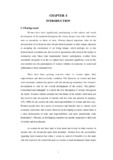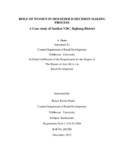Please use this identifier to cite or link to this item:
https://elibrary.tucl.edu.np/handle/123456789/2337| Title: | Role of Women in Household Decision Making Process A Case Study Of Sunikot Vdc, Bajhang District |
| Authors: | Rajak, Bijaya Kumar |
| Keywords: | Women identity;Women empowerment;Bajhang |
| Issue Date: | Dec-2015 |
| Publisher: | Central Department of Rural Development Tribhuvan University Kirtipur, Kathmandu |
| Abstract: | The study entitled ‘Role of women in household decision making process’ is the study to find out the women’s role in decision making process in Sunikot VDC of Bajhang district. This study aims to examine the socio-economic status of women, to compare the effectiveness of job holder and non-job holder women in household decision making process and to explore the problems of women in decision making process. Thus, this study is the key study to find out the situation of women in illiterate Nepalese community This study was based on the qualitative and quantitative data analysis. The data were described on descriptive and exploratory method. This study aimed to meet the target objectives with the help of primary and secondary data. The methodology also incorporated the processing and analysis of data. Thus, this research is completely based on a systematic process. So far socio economic status of the respondent is concerned on the basis of various variables. Most of the village women do not take responsibility in social and economic activities. The women belonged to the age group of 25 to 46 years (38.89%) take part in household decision making process. similarly 68.52% married (59.26% jobholder and 77.78% jobless) women have household decision making power. Likewise, 31.49 % intermediate level complete women make household decision. In the case of religion, 72.22% Hindu women take part in decision making process. similarly, 61.71% women do have 0 to 5 ropani land. In fact, the women who were higher in social and economic status they had opportunity to lead their family. Thus, the social status is one of the key components of decision making process. It was to find out effectiveness between the job holders and non-job holder women. According to the study, 48.15% couples both decide to spend their income. Similarly, 64.71% women have authority to mobilize their saving, 64.81% women expend their income in household activities. Moreover, 50% men decide for family planning, 48.14% women decide for medical treatment and 53.70% men decide for dispute control. The women who were job holder they have decision making power in the family. It is also associated with the economic condition. The finding states that the nature of job of the women is the change agent of making decision. The finding showed some inherent affecting factors of decision making. Among all the respondents 40% illiterate and 40% social and traditional culture affect decision making process. Similarly, 20% women have problem for making decision because of poverty. Moreover, politics, marriage and head of family are also some of the reasons of creating problems in household decision making process. These components were the main fences for women in making decision. These components did not make existence of male in making decision. In conclusion, the study found that the status of women in Sunikot VDC was miserable in decision making process in their family. Very few women have got opportunity for making decision in their family. The main cause of not getting decision making power is illiteracy. The second cause is the condition of job. Specially, non-job holders have no power to make decision. Thus, the most important thing to consider is educating the women and let them participate in the social activities. At the same time, opportunities for job should be provided to the women according to their level and capacity. Some traditional malpractices should not be taken into practice for the betterment of the society and women. |
| URI: | http://elibrary.tucl.edu.np/handle/123456789/2337 |
| Appears in Collections: | Rural Development |
Files in This Item:
| File | Description | Size | Format | |
|---|---|---|---|---|
| thesis.pdf | 1.22 MB | Adobe PDF |  View/Open | |
| font page.pdf | 194.34 kB | Adobe PDF |  View/Open |
Items in DSpace are protected by copyright, with all rights reserved, unless otherwise indicated.
